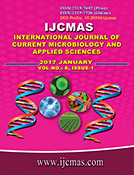


 National Academy of Agricultural Sciences (NAAS)
National Academy of Agricultural Sciences (NAAS)

|
PRINT ISSN : 2319-7692
Online ISSN : 2319-7706 Issues : 12 per year Publisher : Excellent Publishers Email : editorijcmas@gmail.com / submit@ijcmas.com Editor-in-chief: Dr.M.Prakash Index Copernicus ICV 2018: 95.39 NAAS RATING 2020: 5.38 |
Bifidobacteria species (spp.) is common component of normal gut flora. In recent years there are evidences that changes in these species may be associated with asthma in children. The aim of the present study was to study the various components of Bifidobacterium species by culture and polymerase chain reaction (PCR) from the stool from children with bronchial asthma compared to healthy children. The study included ninety children with asthma ≤2 years and ninety healthy children. Stool samples from all children were subjected to specific culture of Bifidobacteria species and biochemical identification. Further confirmation of the isolates was performed by the use of polymerase chain reaction (PCR) with species specific primers targeting housekeeping groEL gene. There was statistical significant difference of the isolation of Bifidobacterium spp rates between asthmatic children and control regarding B. pseudocatenulatum, B. adolescentis, B. catenulatum group and B. longum (P=0.0001 for each). The rates of isolation of Bifidobacteriumspp increased with age in both groups. However, there was statistically significant higher isolation rates of B. pseudocatenulatum, B. catenulatum group and B. longum (P=0.0001), B. adolescentis (P=0.001) at age above 1 year to 2 years in control compared to asthmatic children. There was statistically significant higher rates of isolation of B. pseudocatenulatum in children with history of vaginal delivery compared to those with history of cesarean section delivery and in the rates of the isolation of B. longumin children with normal breast feeding history compared to formula feed (P=0.02). The present study highlights the difference in the prevalence of certain Bifidobacterium spp in children below 2 years between children with asthma and healthy children. B. pseudocatenulatum, B. adolescentis, B. catenulatum group and B. longum were significantly reduced in children with asthma. The constituents of Bifidobacterium spp differ according to the methods of the delivery, feeding habits and with age. The use of molecular method may be the preferred method for study of Bifidobacterium spp. Longituidinal studies with larger numbers of children are required to validate these data. The findings of studies may indicate the usefulness of the use of specific strains of Bifidobacterium spp as specific adjuvant therapy.
 |
 |
 |
 |
 |